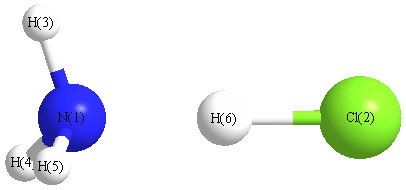Vibrational Frequencies calculated at HF/LANL2DZ
| Mode Number |
Symmetry |
Frequency
(cm-1) |
Scaled Frequency
(cm-1) |
IR Intensities
(km mol-1) |
Raman Act
(Å4/u) |
Dep P |
Dep U |
|---|
| 1 |
A1 |
3704 |
3333 |
6.03 |
111.95 |
0.06 |
0.11 |
| 2 |
A1 |
1733 |
1559 |
2016.83 |
360.85 |
0.39 |
0.56 |
| 3 |
A1 |
1198 |
1078 |
638.16 |
4.07 |
0.14 |
0.24 |
| 4 |
A1 |
173 |
156 |
96.44 |
3.98 |
0.42 |
0.59 |
| 5 |
E |
3880 |
3492 |
31.14 |
50.79 |
0.75 |
0.86 |
| 5 |
E |
3880 |
3492 |
31.14 |
50.79 |
0.75 |
0.86 |
| 6 |
E |
1832 |
1649 |
55.31 |
10.77 |
0.75 |
0.86 |
| 6 |
E |
1832 |
1649 |
55.31 |
10.77 |
0.75 |
0.86 |
| 7 |
E |
1013 |
912 |
160.24 |
9.03 |
0.75 |
0.86 |
| 7 |
E |
1013 |
912 |
160.24 |
9.03 |
0.75 |
0.86 |
| 8 |
E |
344 |
310 |
8.09 |
14.73 |
0.75 |
0.86 |
| 8 |
E |
344 |
310 |
8.09 |
14.73 |
0.75 |
0.86 |
Unscaled Zero Point Vibrational Energy (zpe) 10473.7 cm
-1
Scaled (by 0.8999) Zero Point Vibrational Energy (zpe) 9425.3 cm
-1
See section
III.C.1 List or set vibrational scaling factors
to change the scale factors used here.
See section
III.C.2
Calculate a vibrational scaling factor for a given set of molecules
to determine the least squares best scaling factor.
Charges, Dipole, Quadrupole and Polarizability
Charges from optimized geometry at HF/LANL2DZ
Charges (e)
| Number |
Element |
Mulliken |
CHELPG |
AIM |
ESP |
| 1 |
N |
-0.976 |
|
|
|
| 2 |
Cl |
-0.379 |
|
|
|
| 3 |
H |
0.356 |
|
|
|
| 4 |
H |
0.356 |
|
|
|
| 5 |
H |
0.356 |
|
|
|
| 6 |
H |
0.287 |
|
|
|
Electric dipole moments
Electric dipole components in Debye
(What's a Debye? See section
VII.A.3)
| |
x |
y |
z |
Total |
| |
0.000 |
0.000 |
-5.896 |
5.896 |
| CHELPG |
|
|
|
|
| AIM |
|
|
|
|
| ESP |
|
|
|
|
Electric Quadrupole moment
Quadrupole components in D Å
| Primitive |
|---|
| | x | y | z |
|---|
| x |
-18.989 |
0.000 |
0.000 |
| y |
0.000 |
-18.989 |
0.000 |
| z |
0.000 |
0.000 |
-16.306 |
|
| Traceless |
|---|
| | x | y | z |
|---|
| x |
-1.342 |
0.000 |
0.000 |
| y |
0.000 |
-1.342 |
0.000 |
| z |
0.000 |
0.000 |
2.684 |
|
| Polar |
|---|
| 3z2-r2 | 5.367 |
|---|
| x2-y2 | 0.000 |
|---|
| xy | 0.000 |
|---|
| xz | 0.000 |
|---|
| yz | 0.000 |
|---|
|
Polarizabilities
Components of the polarizability tensor.
Units are
Å
3 (Angstrom cubed)
Change units.
| |
x |
y |
z |
| x |
1.371 |
0.000 |
0.000 |
| y |
0.000 |
1.371 |
0.000 |
| z |
0.000 |
0.000 |
4.124 |
<r2> (average value of r
2) Å
2
| <r2> |
61.434 |
| (<r2>)1/2 |
7.838 |
